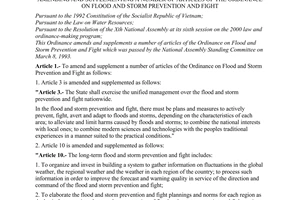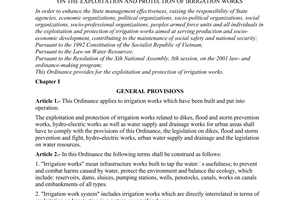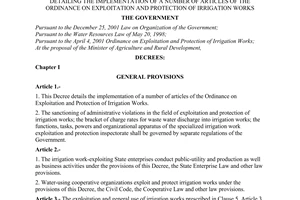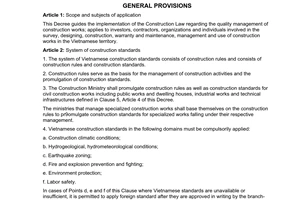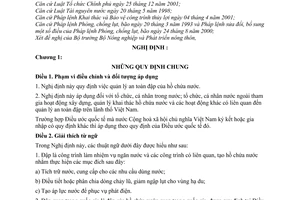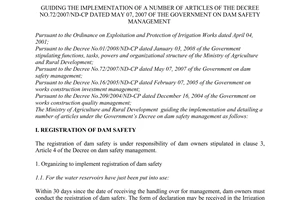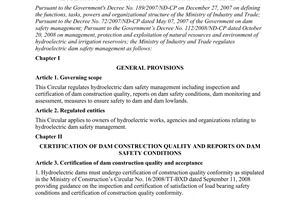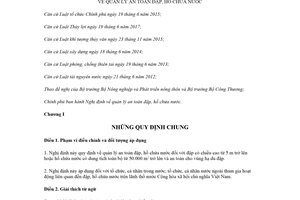Decree No. 72/2007/ND-CP on dam safety management đã được thay thế bởi Decree 114/2018/ND-CP on dam and reservoir safety management và được áp dụng kể từ ngày 04/09/2018.
Nội dung toàn văn Decree No. 72/2007/ND-CP on dam safety management
|
THE GOVERNMENT |
SOCIALIST
REPUBLIC OF VIETNAM |
|
No.: 72/2007/ND-CP |
Hanoi, May 07, 2007 |
DECREE
ON DAM SAFETY MANAGEMENT
THE GOVERNMENT
Pursuant to the December 25,
2001 Law on Organization of the Government;
Pursuant to the Law on Water Resources dated May 20, 1998;
Pursuant to the Ordinance on Exploitation
and Protection of Irrigation Works dated April 04, 2001;
Pursuant to the Ordinance on Prevention and
Combat of Flood and Storm dated March 20, 1993 and the Ordinance on Amending, Supplementing a number of
Articles of the Ordinance on
Prevention and Combat of Flood and Storm dated August 24, 2000;
At the proposal of the Minister of Agriculture and Rural Development,
DECIDES:
Chapter 1:
GENERAL PROVISIONS
Article 1. Scope of governing and subjects of application
1. This Decree stipulates the dam safety management of water reservoirs.
2. This Decree applies to the domestic organizations and individuals, foreign organizations, or individuals engaging in activities of construction, management and exploitation of water reservoirs and other activities related to dam safety management in Vietnam territory.
Where the international treaties which the Socialist Republic of Vietnam has signed or acceded to otherwise provide for, the provisions of such international treaties shall be applied.
Article 2. Interpretation of terms
In this Decree, the following terms are construed as follows:
1. The dam is the project playing the role of water prevention and the relative projects creating water reservoirs to fulfill the following purposes:
a) Water storage and supply for water demand;
b) Regulating or dividing flood flows, reducing flood for downstream;
c) Creating water pressure to serve for electricity generation.
2. National important dam is the dam of the national important water reservoir stipulated in Article 4 of the Decree No.143/2003/ND-CP dated November 28, 2003 of the Government detailing the implementation of a number of Articles of the Ordinance on Exploitation and Protection of Irrigation Works.
3. Big dam is the dam with the height calculating from the floor face to the top of the dam equal to or greater than 15 meters or dam of water reservoirs with the scale of capacity equal to or greater than 3,000,000 m3 (three million cubic meters).
4. Small dam is the dam with the height calculating from the floor face to the top of the dam smaller than 15 meters and creating water reservoirs with the scale of capacity smaller than 3,000,000 m3 (three million cubic meters).
5. The works relating to water reservoirs include: water intake, outlet works, flood discharge works, Locks.
6. Dam owners are organizations and individuals owning dams to harness the benefits of water reservoirs or assigned to manage, operate and harness water reservoirs by the competent state agencies.
7. Dam safety testing is the inspection and evaluation of the quality of dams and the management of dam, made periodically in order to determine the safety of dams.
Article 3. Principles of managing safety of dams
Organizations and individuals relating to the construction, management, harnessing and protection of water reservoirs must comply with the following principles of dam safety management:
1. Ensuring dam safety is the highest priority in the construction, management, exploitation and protection of water reservoirs.
2. The management of dam safety must be implemented regularly, continuously in the process of building and managing the harnessing of water reservoirs.
3. Ensuring the Proactive in dam safety management.
4. Clearly defining the responsibilities of dam owners, ministries, branches and People's Committees at all levels; upgrading sense of community in the management of dam safety.
Article 4. Responsibility of dam owners
1. Management of, ensuring dam safety under the provisions of this Decree and other relative legal provisions relating.
2. Pursuant to the provisions of the Ministry of Agriculture and Rural Development, Ministry of Industry and the competent state agencies, dam owners must organize the units managing dams with sufficient capacity to manage, operate, maintain, repair and protect dam in accordance with provisions.
3. Dam owners must conduct the registration of dam safety at the competent State management agency; be responsible for reporting and providing information relating to dam safety management in accordance provisions.
Chapter 2 :
DAM CONSTRUCTION
Article 5. Survey, design and construction of dams
The survey, design and construction of dams must comply with the construction regulations, standards, regulations on management of construction quality and other relative provisions of law relating.
Article 6. Requirements on safety management for design and construction of dams
1. Overall layout and design of dam structures, besides the ensuring of economic - technical requirements, it is also to facilitate the management of dam safety, including the activities: management, works security protection; test and evaluation of the works quality; dam rescue in time when troubles occur; repairing when the works damaged.
2. For big dams:
a) The water intake, outlet works with its bottom located deep under the crest of the dam must have the corridor to check or appropriate height and width to carry out the inspection and works repair; apart from the main valve gate to operate, regulate water, it must have the valve gate to prevent incidents and serve the works repair;
b) It must build the management route enabling the dam incidents rescue forces and means to access to the works; equip communications systems for ensuring the safety of dams in flood season and devices, materials and necessary preventive equipment;
c) It must arrange appropriate observational equipment, according to geological conditions of the dam foundation, dam structure and construction materials; stipulate observational regime and make observations to test and monitor consecutively the safety state of the dam.
3. For valve gates of flood discharge spillway operated by electricity, other than the main power supply, it must have the backup power.
4. It must have the process of operation and maintenance for each dam work and equipment to install at work.
Article 7. Assigning technical officials managing dam to take part in construction supervision
Right the start of the construction of dams, dam owners must assign technical officials to participate in monitoring the construction, test and acceptance of items and overall of the work to receive and manage when the work is completed; make dam works CV for the construction phase in accordance provisions.
Article 8. Test and acceptance of dam
1. Dam has just been accepted for exploitation and use after being inspected and certified, ensured on quality in accordance with provisions in the Decree No.209/2004/ND-CP of December 16, 2004 of the Government on management of construction work quality and other relative provisions of law.
2. The competent state management agencies decide on the test and acceptance to put into exploitation and use of dams, except for the dams implemented the test and acceptance by the State Acceptance Test Council shall be decided by the Prime Minister.
Article 9. Keeping as archives of technical record
1. When receiving technical documents of construction phase, Dam owners must perform the inspection, review and comparison with reality to have the accurate and clear, full record; implement the arrangements, keeping as archives and preservation of records in accordance with provisions.
2. In the process of managing dams, the dam owners must add to the archived records the documents on observation, dam safety examination and inspection, technical documents of dam overhaul and the relative administrative written decisions.
Chapter 3:
DAM MANAGEMENT
Article 10. Water regulation of reservoirs
1. Dam owners must make the process of water regulation of reservoirs, provisions of water storage, water discharge; in the normal conditions and in emergency situations, dam owners submit to the competent state management agencies for approval and organization of implementation.
2. Water regulation of reservoirs in compliance with the following provisions:
a) Not to store water in the reservoir above the level provided by state management agencies;
b) Where dams are damaged or got in troubles, with request of discharging water to lower the water level, dam owners must control the speed of lowering the water level so as not causing sliding, landslide upstream roof of dam;
c) During flood season, the water reservoirs play the role of regulation of flood, the operation of water storage; the flood discharge must be ensured to prioritize dam safety, perform the regulation to cut flood and water storage in the reservoir according to the works’ tasks.
Article 11. Valves gate operation of works
The operation of valve gates of the water intake, outlet works, flood discharge works, Locks is stipulated as follows:
1. Dam owners must make and submit to the competent authorities for promulgation or promulgating according to authority the documents defining the competence to order the operation and process of acting and operating valve gates of each work (hereinafter referred to as the works operation).
2. Seriously prohibiting persons without competence to order or force the work operation.
3. Seriously prohibiting the action of work operation; only the responsible persons are entitled to operate the works.
4. It must stipulate the regime and implementation for the trial operation of valve gates not being operated regularly, including the preventive valve gates.
5. It must record the operation, trial operation of valve gates of works in a book of monitoring the work operation.
Article 12. Dam observational measurement and hydrologic-meteorological factors
1. For big dams:
a) After being handed over to manage, dam owners must hold the measurement, observation or signing of contract with the specialized units to perform the observation measurement, gather hydrologic-meteorological factors above the basin of the water reservoir, the evolution of water permeability, leakage through the body, the foundation, shoulder, relocation of the dam, the evolution of crack, sliding at body, foundation and adjacent scope of the work, the sedimentation state of the reservoir;
b) Documents of observation, measurement must be corrected, codified, analyzed, evaluated, compared with forecast design data; detecting mutations for decisions to handle timely; carrying out the keeping as archives of documents in accordance with provisions.
2. For small dams: it must perform the observation of reservoir water level and other observational measurements provided by dam design consultancy units.
Article 13. Repair, maintenance of dams
1. Dam owners must stipulate specifically the contents and regime of repair, maintenance for each work, work division and equipment.
2. Repair, maintenance of dams and equipments must be conducted periodically, regularly as prescribed to ensure the works operated reliably, safely aiming to inspect easily, detect damages for restoration, repair in time and ensure the aesthetics of the work.
Article 14. Inspection of dams
Dam owners must perform the inspection of dam according to contents and regime provided, including:
1. Regularly inspect through analysis and assessment of materials on dam measurements, observations and visual examination at site.
2. Periodically inspect before and after the annual flood:
a) Every year, at the time before entering the flood season, it must conduct the examination, overall assessment of dam stability; coordinate closely with the Steering Committee for the prevention and combat of floods and storms of Ministries, Branches and localities to build or update and supplement plan of the prevention and combat of dam’s floods and storms and the plan of prevention and combat of lowlands’ flood;
b) At the time after the end of flood season, it must conduct the inspections to detect damages (if any); to monitor the evolution of the dam damages; take experience in the prevention and combat of floods and storms; propose measures and plans to repair and overcome damages;
c) The time of conducting the inspection before the flood season, after the flood season is provided corresponding to the areas as follows:
- April and November for the provinces in North, Central North;
- April and December for the provinces in the West Highlands, South East;
- August and January of the following year for the provinces in the South Central Coast.
3. Conducting irregular inspection right after great flood, big earthquake takes place or unexpected failure is detected.
4. Dam inspection and survey in detail: when the dam is heavily damaged, the dam owner must organize to inspect, survey in detail to determine the causes, extent and scope of the damage; conduct to design for repair; and implement proactive measures in prevention, combat, ensuring of dam safety and downstream areas safety.
Article 15. Restoration, repair and upgrade of dams
1. It must conduct the restoration, repairing and upgrading of dams as one of the following situations take place:
a) Dams are heavily damaged, not ensuring safety;
b) Flood discharge works lack flood discharge capacity according to design standard as provided;
c) Due to changes to design standards leading to the dam failing to satisfy stable condition under the new design standards.
d) The reconstruction of reservoir bank is made affecting the dam safety.
2. The restoration, repair and upgrade of the dam are conducted under the regulations on current construction investment management.
Article 16. Report of dam safety status
1. Every year, the dam owner must make and submit reports to the Ministry of Industry, Ministry of Agriculture and Rural Development and the relevant agencies in accordance with provisions on the current status of dam safety. Contents of reports include:
a) Highest flood discharge level in reservoirs; the largest flood flow into reservoir (time to appear, the flood peak capacity, total volume of flood, the process of flood discharge);
b) Results of measurement, observation of dams have been corrected, analyzed and evaluated;
c) Damages of works and the repair, remedy;
d) Results of work inspection before the flood;
đ) Other relative necessary contents.
2. Time to send reports stipulated as follows:
a) Before May 15 for the provinces to be of North, North Central, Southeast, West Highlands;
b) Before September 15 for the provinces to be of South Central Coast.
3. Dam owners must report promptly to the competent state management agencies when the following situations take place:
a) Detecting sudden changes on results of permeability measurements, relocation of the dam;
b) Dams were heavily damaged or the previous damages happening upon worse trend;
c) Troubles in valve gate operation of the works in the flood season;
d) Heavy rains in the basin of the reservoirs when it is filled;
đ) Suspicion to have the plot of dam sabotage.
Article 17. Testing on dam safety
1. It must test periodically the safety for the dams of the water reservoirs with storage capacity equal to or greater than 10 million m3 (ten million cubic meters), according to the following provisions:
a) The testing is done periodically not exceeding 10 years since the date that the reservoir has stored water or from the latest testing times.
b) The testing work is conducted by the dam owners. Dam owners select testing consultancy units qualified in accordance with provisions of the Ministry of Agriculture and Rural Development.
c) Contents of the testing include:
- Valuation of results of dam management upon the contents prescribed in Chapter III of this Decree;
- Inspection, material analysis of dam measurement, observation;
- Inspection, quality valuation and safety of dam;
- Inspection of reservoir’s sedimentation status;
- Calculation of flood, flood discharge capacity of the water reservoirs according to current dam design standards and hydro-meteorological documentation updated;
- Valuation of results of implementing the prevention, combat of flood, storm at site.
d) The testing results must be reviewed, approved by the competent state management agencies.
2. For the reservoirs with storage capacity less than 10 million m3 (ten million cubic meters), according to every 7-year, dam owners must re-calculate flood flows to the reservoirs, check the reservoirs' flood discharge capacity according to current dam design standards on the basis of updating on hydro-meteorological observation documents and changes of topography, geomorphology, land cover level of vegetation in the reservoirs basin, file reports submitting to the competent state management agencies for consideration and approval.
3. Dam owners are responsible for paying for costs of dam safety testing consultancy.
Chapter 4:
ENSURING OF DAM SAFETY AND LOWLAND AREAS
Article 18. Scope of dam protection
1. The scope of dam protection includes dams and the adjacent areas.
2. Dam owners are responsible for determining, setting up boundary of scope of adjacent areas to protect dam in accordance with provisions in Article 25 of the Ordinance on Exploitation and Protection of irrigation works; be responsible for ensuring dam safety and scope of adjacent areas to protect dam in accordance with provisions in Article 26 of the Ordinance on Exploitation and Protection of irrigation works and other relative provisions of law.
3. For the reservoir foundation region, the provincial-level People's Committees based on characteristics of the local situation to stipulate specifically and implement to set up the boundary; be responsible for managing the scope of adjacent areas to protect the works in accordance with provisions.
Article 19. Plan to protect dams
1. Dam owners must make the plan to protect dams, submitting to the competent state management agency for approval and implement in accordance with provisions in the Ordinance on Exploitation and Protection of irrigation works and other relative provisions of law.
2. Dam protection plans must be based on the size of dams, location of the dams and dam’s importance on economy, national security and security order situations in the locality to mention the following main issues:
a) Regular protection, invasive combat of dams;
b) Organization of patrol, guarding at the key positions when heavy rain, floods take place;
c) Organization to inspect, control persons and means of sightseeing, tourism, visitors coming to work, to survey dams;
d) Solutions to deal with special situations and prevent the plot to sabotage dams;
đ) Regulations on restricting or prohibiting the types of vehicles with heavy load circulating on the dam face, especially in the flood, rainy season;
e) Other issues relating to dam protection.
Article 20. Ensuring of dam safety in the flood, rainy season
1. Dams to be of type of flood and storm prevention and combat work. Every year, before entering the flood, rainy season, the dam owners must make or update and supplement the plan of flood and storm prevention and combat submitting to the competent state management agencies for approval.
2. Contents of the plan of flood and storm prevention and combat include:
a) Summarizing characteristics, situations of the water reservoirs relating to the prevention and combat of floods and storms;
b) Revolution of the situation and characteristics of floods, raining on the basin of the reservoirs;
c) Assessing the quality of the dam and dam operating equipment;
d) Expecting the dam unsafe situations which may occur and technical solutions to predict, detect, cope with and warn floods;
đ) Preparation of human resource, raw materials, reserve materials; tools, equipment, motorbikes; communications, light;
e) List of Steering Committee of flood and storm prevention and combat.
3. After the plans are approved, the preparation must be deploy to implement; materials, reserve tools must be gathered and stored in the specified locations; technical officials, the rescue force, means must be managed according to provision available for mobilization when needed. The Steering Committee of flood and storm prevention and combat must conduct the meetings, passing the regulation of work and on duty regime.
4. During the flood, rainy season, dam owners must maintain communication regime, status report regime to the Steering Committee of flood and storm prevention and combat of higher level and the competent state management as provided.
Article 21. Dam rescue
Where incidents occur, they could cause dam un-safety, the rescue must be deployed on emergency with efforts and highest priority to keep safety for the works, minimize damages.
People's Committees at all levels based on the functions, tasks, powers of their own are responsible for organizing the rescue for dams in the area and joining the rescue for dams for the locality as prescribed by law .
Article 22. Prevention, combat of flood for the lowland areas of dams
1. In case of operating flood discharge of reservoirs making water levels of lower river, stream of flood discharge works rise dramatically, dam owners must take measures to alarm, notify in advance to ensure safety for people, ships, boats and means of transport, operation on rivers and streams.
2. Dam owner must make and submit to the competent state management agency for approval of the plans to prevent, combat floods for the dam lowland area to actively cope with flood situations due to emergency flood discharge or dam break situations aiming to protect people's lives and mitigate damages on people and property of the dam lowland area.
Chapter 5:
STATE MANAGEMENT ON DAM SAFETY
Article 23. Contents of state management on dam safety
Contents of state management on dam safety include:
1. Construction, issuance and inspection of the implementation of legal documents on management of dam safety, the regulations, technical standards on dam safety management.
2. Conducting the examination, inspection and supervision on dam safety.
3. Decision on acceptance test, handing over of dams.
4. Approval of the process of regulating reservoir water, plan of dam protection, plan of flood and storm prevention, combat aiming to ensure dam safety, plan of flood and storm prevention, combat of lowland areas.
5. Decision on the measures of handling, mobilize forces, materials, means to solve dam troubles.
6. Granting, revoking, extending license for the operations which are required to have license within the scope of dam protection.
7. Organizing to research, apply technical advance and technology into construction, management, exploitation, and protection of dams, flood prevention, combat of lowland areas.
8. Organizing to propagate, disseminate law and information relating to management of dam safety.
9. Training, fostering professional skill to officials, staffs doing the works of management, operation, protection of dams and management of dam safety.
10. Organizing to implement the international cooperation in the field of management of dam safety.
Article 24. Responsibility of the state management agencies on dam safety
1. The Government agrees state management on dam safety in the whole nation.
2. The Ministry of Agriculture and Rural Development takes responsibility before the Government for the implementation of state management of dam safety, including:
a) Making and submitting to the Government, the Prime Minister for promulgation or promulgating according to its competence the legal documents, regulations and standards on dam safety management.
Presiding over and coordinate with the Ministries, Branches and relative localities to set up and guide the implementation of plans, policy on dam safety management and inspect the implementation;
b) Decision on acceptance test, handing over of dams approved the investment by the Ministry;
c) Approving the process of regulating water for the reservoirs managed by the Ministry and for the reservoirs managed by the provincial-level People's Committees (except for hydropower reservoirs) that the exploitation and protection related to two provinces or more;
d) Presiding over and coordinate with the Ministry of Public Security, the Defense Ministry and the provincial-level People's Committees to build the plan to protect national importance dams submitting to the Prime Minister for approval; approving or decentralizing the provincial-level People's Committees to approve dam protection plans managed by Ministry;
đ) Approving the plan of flood, storm prevention and combat for dams managed by the Ministry;
e) Decisions upon its competence or reporting, submitting to the Prime Minister for decision on measures, forces mobilization, materials and facilities to prevent, combat floods, storm to ensure dam safety, dam rescue and flood prevention, combat for the lowland areas for dams under the Ministry’s management;
g) Inspection and examination, supervision of the testing on safety for dams under the Ministry’s management;
h) Performing the other state management responsibilities on safety for dams under the Ministry’s management.
3. Responsibilities of the Ministry of Industry
The Ministry of Industry presides over and coordinate with ministries, branches and relative localities to appraise, approve or submit to the Prime Minister for approval of the process of operating hydropower reservoirs in accordance with provisions in the Decision No.285/2006 / QD-TTg dated December 25, 2006 of the Prime Minister and takes responsible for state management on hydropower dam safety, including:
a) Making and submitting to the Government, the Prime Minister for promulgation or promulgating according to its competence the legal documents, regulations and standards on hydropower dam safety management;
b) Decision on acceptance test, handing over of hydropower dams approved the investment by the Ministry;
c) Making the process of operating the big hydropower reservoir, integrated exploitation according to provisions of the Prime Minister; approving or decentralizing the provincial-level People's Committees to approve the process of regulating water of other hydropower reservoir under Ministry’s management;
d) Presiding over and coordinate with the Ministry of Public Security, the Defense Ministry and the provincial-level People's Committees to build the plans to protect national important hydropower dams submitting to the Prime Minister for approval; approving or decentralizing the provincial-level People's Committees to approve the plan to protect other hydropower dam under Ministry’s management;
đ) Presiding over and coordinate with ministries, branches and relative localities to appraise, approve the plan to prevent, combat floods and storms, to ensure the safety for dams under Ministry’s management;
e) Granting, extending, revoking license or decentralizing the provincial-level People's Committees to grant, extend, revoke license for the operations which are required to have license within the scope of hydropower dam protection under Ministry’s management;
g) Inspection and examination, supervision of the testing on safety for hydropower dams;
h) Decisions upon its competence or reporting, submitting to the Prime Minister for decision on measures, forces mobilization, materials and facilities to prevent, combat floods, storm to ensure dam safety, dam rescue for the lowland areas for the hydropower dams under Ministry’s management;
i) Implementing other state management responsibilities on safety for the dams under Ministry’s management.
4. Responsibilities of the provincial-level People's Committees
The provincial-level People's Committees implement its state management on dam safety in the area, including:
a) Promulgating according to its competence and organizing to implement the legal documents on safety management for dams under Province’s management;
b) Performing examination and inspection on safety for dams managed by the province, organizing and supervising the safety testing for the dams of the reservoir with capacity of less than 10 million m3 (ten million cubic meters) managed by the province;
c) Decision on acceptance test, handing over for the dams approved the investment or granted the construction license by the provincial-level People's Committees;
d) Approving the process of regulating water to the reservoirs managed by the province (except for the water reservoirs that the exploitation and protection related to two provinces or more), plan of flood, storm prevention and combat for the dam, the plan of flood, storm prevention and combat for the region to be of the provincial area in the lowland area of dam;
đ) Approving the plan of dam protection managed by the province (except for the national important dams);
e) Deciding upon its competence the measures to handle in emergency in case of dam’s incidents arise, organizing to rescue dams in the local area;
g) Granting, revoking, extending license for activities which are required to have license within the scope of dam protection (except for hydropower dams managed by the Ministry of Industry) and within scope of adjacent area of works protection for the reservoir foundation area to be of provincial area;
h) Implementing other relative state management responsibilities on safety for the dams under Province’s management.
5. Responsibilities of the Central Steering Committee of flood, storm prevention and combat and the relative ministries, branches
The Central Steering Committee of flood and storm prevention and combat and the relative ministries, branches implement the responsibilities of ensuring dam safety according to provisions of the 1993 Ordinance on flood and storm prevention and combat, the 2000 ordinance Amending, Supplementing and the Decree No.08/2006/ND-CP dated January 10, 2006 of the Government on guiding the implementation of a number of Articles of the Ordinance on flood and storm prevention and combat.
Chapter 6;
REWARDS AND HANDLING OF VIOLATIONS
Article 25. Rewards
Organizations and individuals having achievements in ensuring the safety of dams, combating against violations of laws on dam safety management are rewarded according to law regulations.
Article 26. Handling of violations
Organizations and individuals who are lack of sense of responsibility, abuse their positions, powers, cover up the violations of law on dam safety management; individuals or organizations who do not comply with the competent state agency's mobilization when the work happens troubles; destroy or cause un-safety for dam or have other violations under the regulations, depending on the nature and seriousness of their violations, shall be administratively sanctioned or examined for penal liability, if causing damages, must pay compensation as prescribed by law regulations.
Chapter 7:
IMPLEMENTATION PROVISIONS
Article 27. Effect
This Decree takes effect 15 days after its publication in the Official Gazette.
Article 28. Responsibility of implementation
The Ministers, Heads of ministerial-level agencies, Heads of Governmental agencies, Presidents of the People’s Committees of provinces and cities directly under the Central Government are responsible for the implementation of this Decree./.
|
|
FOR THE GOVERNMENT |
------------------------------------------------------------------------------------------------------
This translation is made by LawSoft and
for reference purposes only. Its copyright is owned by LawSoft
and protected under Clause 2, Article 14 of the Law on Intellectual Property.Your comments are always welcomed
